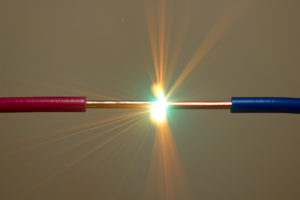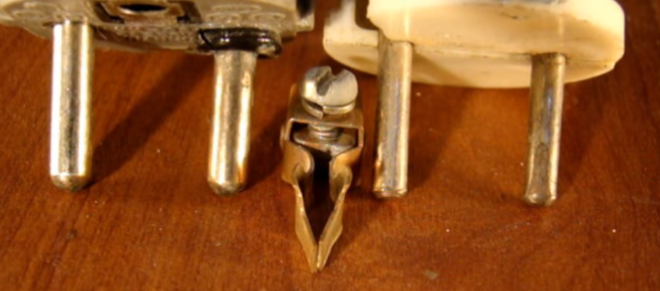The socket sparkles or heats up - we understand the reasons and fix the malfunction
If the socket sparks, then first of all you need to look at exactly when the spark occurs - during operation or when the plug is turned on. It is easy to distinguish between them - in the first case, it is a long characteristic crackle of an electric discharge, in which the plug often heats up. In the second case, a loud crack is heard at the moment when the plug enters the outlet, and then everything works as usual. Based on this initial diagnosis, a method for further solving the problem is selected.
Content
Crackle when plugging in
This phenomenon is observed quite often - for example, if you leave home for a few days and unplug electrical appliances from the sockets. Upon returning, everything turns back on and here in some outlets a noticeable flash is visible and a loud crack is heard.
Causes of occurrence

Despite the fact that it all looks quite menacing and makes many people reflexively pull their hands away from the sockets, there is nothing in this phenomenon indicating a malfunction. It's just that when the contacts of the plug come close to the contacts of the outlet, an electric discharge arc jumps between them a moment before contact between them. This is the nature of the electric current and the higher the voltage at the contacts, the greater the distance such an arc can stretch.
In industrial conditions, special arc-extinguishing chambers are made near the contacts of the starting devices, and in especially powerful devices for this, devices are even used to extinguish the arc with compressed air or in another way.
Interestingly, the reflexive withdrawal of the hand from such an outlet is completely meaningless. And not because this phenomenon is not dangerous, but because of deception of sight and hearing due to the imperfection of these senses. The fact is that the micro-lightning arising from contact of the contacts lasts a hundredth, if not a thousandth of a second. Given that the human eye perceives everything at a speed of 24 frames per second, it sees only the original image imprinted on the retina and gradually fading away. The same is with sound - the audible crackling is thunder in miniature - first, the primary disturbances of the air reach the ear, and then the consequences of the displacements of its molecules.
What can be done
It would seem that the issue has been resolved and now you can simply not be afraid of this phenomenon, if not for one "but" - not every outlet sparks ... It is even more surprising if all installed sockets are the same, which means that it will not be possible to explain such behavior by differences in design.
The reason is simple - plugs are inserted into some sockets from turned off devices, and into others, on the contrary, from turned on. Take a computer for example - usually all of its peripherals are connected to one surge protector for 5-6 sockets. This is the system unit itself, a monitor (or even two), speakers, a printer, a router - maybe something else is connected. When the computer is turned off, in fact, it is not completely de-energized - all its components are in standby mode, so if you unplug the power strip from the outlet, it will "remember" its last state. Accordingly, when the plug is again inserted into the outlet, all the devices at once "fucking" electric current on themselves, which will cause a discharge in the outlet.
This will not happen if you disconnect each device separately before leaving - manually turn off the monitors, turn the switch on the power supply unit of the system unit, flip the toggle switch on the speakers and the printer.Then, when the plug is plugged into the socket, the circuit will not close and there will be no discharge.
How does it affect the outlet
Theoretically, even if micromolding occurs, the surface of the contacts burns up and may become unusable over time - the resulting carbon deposit will cover everything with a film with great resistance, this place will begin to heat up and the socket may begin to melt.
In practice, the discharge hits the tip of the plug and at the very beginning of the socket contact - when the plug is fully inserted, the working surface of the contacts is completely different. Moreover, if the plug comes out of the socket infrequently, then the contact is very far from damage.
As a result, when the outlet sparks when the plug is turned on, you need to realize that everything has already happened and just insert the plug further.
If the socket bursts during operation
If a crack is heard when the plug is in the outlet, then this is already a sign of poor contact in some part of the electrical circuit. Often, over time, the surface of the plug or the outlet itself heats up over time, or even all at once.
Causes of crackling in a working outlet

In fact, the working outlet makes noise for the same reason as when the plug is inserted - the contacts do not touch closely, but in places do not reach each other. The standard consequences are that their surface is oxidized, resistance to electric current increases and metals begin to heat up.
In the same way, the socket bursts if the bolted connections are loosened - the wire inside the contact begins to move and protrusions are formed, between which sparks appear. The socket starts to make noise, and if the contact is very poor, it can heat up and melt.
Also, the cause of sparking may be a mismatch in the diameter of the pins of the plug and the contacts of the socket, a typical example is when an old Soviet plug is inserted into a modern Euro socket.

See details in this video:
The fourth common reason why the outlet heats up is the discrepancy between the power of the devices connected to it and the throughput of the wires. If you rub something against each other, then both of these things will heat up, and the electrons inside the conductor "run" at the speed of light. As a result, if the wiring periodically runs at the limit of its bandwidth, then it warms up.
This is not critical for the lived themselves, but the insulation, which is constantly softening and hardening, loses its properties over time. This should also take into account the ability of the electric current to straighten the wiring through which it is passed. When a powerful device is turned on through a weak conductor, the heating core heats up the insulation, which becomes soft and is "picked out" by the wire trying to straighten. Ordinary vibration, which appears in devices powered by electric current, can also have its say. It can be invisible to the naked eye, but such wiring does not always shorten immediately. Over time, the core can crawl out of the insulation and then, at best, a sparking contact will turn out, and at worst, it will reach a short circuit.
Elimination methods
Conceived, when sparking occurs, it is enough to sort out the sockets - if you disassemble them, then what to do next is usually visible to the naked eye. A place with poor contact is distinguished by scale from melting the insulation, and it itself is hardened and brittle. If there is a little carbon deposit, then it can be simply cleaned off and tightened the bolted connections. When it comes to serious melting of the insulation of the wires or the socket housing, it is strongly recommended to replace them.
Choice of sockets, plugs and tees
The reason for the malfunctioning of the outlet may also be the poor quality of both the outlet itself and the plug of the electrical appliance, this problem is discussed in detail in the following video:
As a result
All household electrical wiring is calculated with a multiple margin of safety, so if the outlet sparks, the plug or the extension cord heats up, then this is a signal for an early search and correction of the malfunction.
The problem may not be found right away - this most often indicates that a device whose power is higher than the wiring can pass through is connected to the outlet. In this case, you need to look for a “weaker” device or make an additional outlet.





